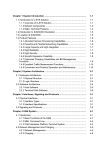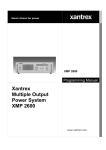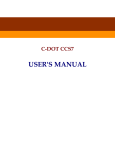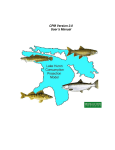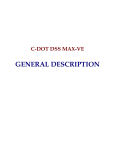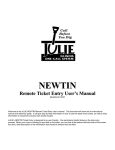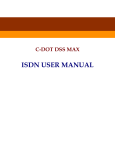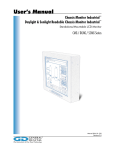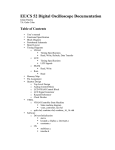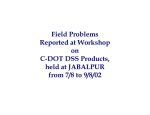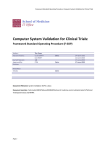Download C-DOT IN
Transcript
C-DOT IN SSP ADMINISTRATION Section No. 404-406-0723 System Practices Draft 02, March 1999 C-DOT IN SSP ADMINISTRATION © 1999, C-DOT Printed in India C-DOT IN SSP ADMINISTRATION DRAFT 02 MARCH 1999 CHAITRA 2055 SERIES 400 : ADMINISTRATION CSP SECTION NO. 404-406-0723 THIS C–DOT SYSTEM PRACTICE REFERS TO THE C–DOT INTELLIGENT NETWORK (ABBREVIATED AS C–DOT IN IN THE REST OF THIS PUBLICATION). THE INFORMATION IN THIS SYSTEM PRACTICE IS FOR INFORMATION PURPOSES AND IS SUBJECT TO CHANGE WITHOUT NOTICE. A COMMENT FORM HAS BEEN INCLUDED AT THE END OF THIS PUBLICATION FOR READER'S COMMENTS. IF THE FORM HAS BEEN USED, COMMENTS MAY BE ADDRESSED TO THE DIRECTOR (SYSTEMS ), CENTRE FOR DEVELOPMENT OF TELEMATICS, 39, MAIN PUSA ROAD, NEW DELHI - 110 005 © 1999 BY C–DOT, NEW DELHI. Table of Contents Chapter 1. Introduction ..............................................................................................................................5 1.1. Purpose & Scope ...............................................................................................................5 1.2. Organisation of Contents .................................................................................................5 Chapter 2. Command Directory .................................................................................................................6 2.1. Introduction.......................................................................................................................6 2.2. Command Directory..........................................................................................................6 2.3. Command Flow .................................................................................................................6 Chapter 3. Parameters Description .........................................................................................................10 3.1. Introduction.....................................................................................................................10 3.2. Parameters Description..................................................................................................10 Chapter 4. Operator Command Sheets....................................................................................................18 4.1. Introduction.....................................................................................................................18 4.2. IN Administration Commands : Update Class .............................................................20 4.3. IN Administration Commands : Display Class.............................................................54 Chapter 5. Traffic Administration Commands........................................................................................68 5.1. Introduction.....................................................................................................................68 5.2. Command Directory for IN Reports ..............................................................................70 5.3. Command Sheets for Existing Commands Modified for IN.........................................72 5.4. Command Sheets for New IN commands......................................................................93 Annexure - I Command Sheets Index .........................................................................................................96 Annexure - II Guidelines for IN Data Creation ...........................................................................................97 Annexure - III List Of Announcements Used ..............................................................................................120 H:\HOME\IN\WORD\INADMVLD.DOC March 9, 1999 Chapter 1. Introduction 1.1. PURPOSE & SCOPE This document describes the Intelligent Network (IN) related man machine commands available in C-DOT Service Switching Point (SSP). The command parameters and input and output formats for each command have been described in a structured manner for easy comprehension and reference. The sequence of commands is the same as they appear in the administration and maintenance command menus. This document purports to be a reference on IN related MML commands. This can be used by operators and validation personnel alike. Please note that C-DOT SCP administration interface has been described in a separate document titled – “C-DOT IN SCP Administration Interface.” 1.2. ORGANISATION OF CONTENTS The contents of this document are spread over five chapters and two annexures. Chapter 1 is introductory in nature. Chapter 2 gives the complete list (directory) of C-DOT SSP administration commands. Chapter 3 contains detailed description of command parameters. The reader will often come back to this chapter for reference in time of doubt. Although online help is available, a better description of the command parameters is available here. Chapter 4 describes the format in which the MML commands are issued and their results displayed. Illustrations of the operator command input and output forms are also given. Chapter 5 describes the input and output formats of IN related traffic reports. Command sheet index is available in Annexure - I. Guidelines for SSP data creation are given in Annexure - II and will be particularly useful for field units installing a SSP or retrofitting SSP capability in an existing switch. SSP ADMINISTRATION 5 Chapter 2. Command Directory 2.1. INTRODUCTION Commands are the tools which can be used to observe, record, manipulate and display exchange data. For the purpose of incorporating requirements specific to SSP implementation, administration and maintenance commands have been added to the existing MML command set of C-DOT DSS MAX. SSP administration commands are grouped under two classes in the CRP main menu. 2.2. Class 46 IN Update Commands Class 47 IN Display Commands COMMAND DIRECTORY The command directory serves the function of a central reference point for all the commands. By looking at the various entries in the directory the operating personnel get on idea of the function performed by a command, its mnemonic and the position defined parameters required for its execution. The directory is divided into two parts corresponding to the two IN command classes and is given in Table 2-1. 2.3. COMMAND FLOW Irrespective of the command, all the commands when executed, follow a similar pattern of man-machine interaction. Command flow is the interaction between the operating personnel and the software, more specifically, the Command Recognition Process (CRP). As an illustration, the command flow for Create IN Service (CRE-IN-SRV) command is given in the following paras. 1. 6 At the CRP prompt (>), either give the command CRE-IN-SRV or the menu path for this command, i.e., 1 (Administration Main Menu), 46 (IN Update Commands), 4 (Create IN Service). The path will be specified by typing MENU 1 46 4. C-DOT IN COMMAND DIRECTORY Yet another method would be to traverse the menus and choose the appropriate option. In any case, let us assume that the command has been correctly issued. 2. 'Security Checks' are performed by CRP, i.e., whether the operator has the authority to issue this command. This authority is granted to an operator while adding a new operator via ADD-OPR command. 3. Parameter Entry Form is displayed if security check has been passed. The form contains : ♦ The command mnemonic, command name and all the position-defined parameters required to execute the command. ♦ Non-essential parameters, i.e., default value exists for them, are shown enclosed in square brackets while essential parameters are without brackets. For example, in this case, all the parameters except TGR-TYP, SRV-CAT and SCP-ID are optional parameter. 4. User enters parameter values as desired. Error messages will be displayed for illegal entries. Online 'Help' is available for each parameter and can be accessed by typing 'h' and 'CR' (Carriage Return) while the cursor is at the desired parameter. ♦ Option to Repeat/Terminate/Execute (R/T/E) the command with the given input parameters. 5. User enters the "Execute" i.e. "E" option. The system will respond by displaying the message : Executing .... Now, the Command Execution Process (CEP) validates the parameters entered. If CEP detects any error, the command is rejected and an MMC error message is displayed by CRP. The error message contains error number, error statement, entity id and error dictionary reference. Let us assume that parameter validation was successful. 6. Since the command has been executed successfully, CRP will display output results in the form of "Output Forms" which may occupy one or more VDU screen and/or printer pages. The results will be sent to VDU, printer, or both VDU and printer depending upon the option already chosen by the operator via CHG-OUT-DEV command. SSP ADMINISTRATION 7 Chapter 2. Table 2-1 : IN Administration Commands Directory Class 46 : IN Administration Update Commands S.No. 8 Command Mnemonic Command Name Position Defined Parameters 1. CRE-TGR-TYP Create a trigger type TGR-TYP, DP, PRCD, [TGRCRI], [STAT-COD] 2. DEL-TGR-TYP Delete a trigger type TGR-TYP 3. MOD-TGR-TYP Modify the characteristics of a trigger type TGR-TYP, STAT-COD 4. CRE-IN-SRV Create an IN service SRV-KEY, SRV-NAME, DP-TYP, TGR-TYP, [MIN-DGT] [MAXDGT], [DIGITS], [DL-PLAN], [CLS-SRV], [NAT-ADR], [CAUSE], SRV-CAT, [IN-TYP], SCP-ID, [FLT-TONE], [FLT-DIR] 5. DEL-IN-SRV Delete an IN service SRV-KEY 6. MOD-IN-SRV Modify the characteristics of an IN service SRV-KEY, [DP-TYP], [MINDGT], [MAX-DGT], [DIGITS], [DL-PLAN], [CLS-SRV], [NATADR], [CAUSE], [SRV-CAT], [INT-TYP], [SCP-ID], [FLTTONE], [FLT-DIR] 7. MOD- INTONE-MAP Modify IN tone mapping TONE-MAP 8. MOD-ESC-LIST Add/Delete escape codes in/form escape code list. OPR-TYP, ESC-COD 9. CRE-IN-GRP Create a VPN group GROUP-ID, [MEMBER DIRNOs] 10. DEL-IN-GRP Displays a VPN group GRP-ID 11. GRNT-IN-SRV Grants VPN service to a group SRV-KEY, DIRNO, GRP-ID, [FLT-TONE], [FLT-DIRNO] 12. ADD-SUB-TOGRP Adds subscriber to VPN GRP-ID, DIRNO 13. REM-SUB-FRMGRP Remove subscriber from group GRP-ID, DIRNO 14. WTD-IN-SRV Withdraw IN service SRD-KEY, DIRNO, GRP-ID C-DOT IN COMMAND DIRECTORY Table 2-1 (Contd.) : IN Administration Commands Directory CLASS 47 : IN Display Commands S.No. Command Mnemonic Command Name Position Defined Parameters 1. DISPL-TGR-TYP Display the characteristics of trigger type [TGR-TYP], [DP] 2. DISPL-IN-SRV Display the characteristics of an IN service SRV-KEY 3 DISPL-INTONE-MAP Display IN tone mapping No parameter required 4. DISPL-ESC-LIST Display escape code list No parameter required 5. DISPL-IN-GRP Display a VPN group GRP-ID SSP ADMINISTRATION 9 Chapter 3. Parameters Description 3.1. INTRODUCTION On issuing a command with valid mnemonic and syntax, the system responds by displaying a parameter entry form in which the parameters required for execution of that command are to be specified by the operator. Parameters are variables which identify and contain a piece of necessary information to execute a command. Although online 'help' is available on the parameter entry form, it is very important for the operating personnel to understand the correct application of each parameter. Some of the parameters are used in more than one command. In the parameter description to follow, such parameters are discussed only once alongwith necessary qualifying remarks. Parameter description for each parameter is covered under the following subheads: 3.2. MNEMONIC (Parameter Name): : Address code in the form of a pronounceable word (Name of the Parameter) TYPE : ASCII, numeric or logical, i.e., type of data acceptable POSSIBLE VALUES : A set of values and/or range acceptable. DEFAULT VALUE : The value automatically assigned by the system if the operator does not assign any value, i.e., just presses the <Return> key. REMARKS : Some more information regarding special attributes of the parameter and their usage. PARAMETERS DESCRIPTION On the proceeding pages, all the parameters used by IN related administration and maintenance commands are described in the format described above in section 3.1. 10 C-DOT IN PARAMETERS DESCRIPTION 3.2.1. BM-NO (Base Module) TYPE : Alphanumeric POSSIBLE VALUES : BM-01 to BM -32 DEFAULT VALUE : Mandatory REMARKS : Base Module number is indicated. 3.2.2. CAUSE (Cause) TYPE : Alphanumeric POSSIBLE VALUES : NONE, UNALLOC-NUM, NO-ROUT, TO-NET, NOROUT-TO-DESTN, NRML-CALL-CLR, USER-BUSY, NUM-CHNG, DESGN-OUT-OF-ORDER, NORMALUNSPEC, NO-CKT-AVAIL, SWITCH-CONG, RSRCENOT-AVAIL DEFAULT VALUE : NONE REMARKS : This indicates the cause of call failure. 3.2.3. CLS-SRV (Class of Service) TYPE : Alphanumeric POSSIBLE VALUES : ALL, LINE-CCB, LINE-PARTY, TRUNK-DEC, TRUNKMF, TRUNK-SS7, PVTFAC-DEC, PVTFAC-MF, PVTFAC-SS7, ORD-CCB, CRDT-CCB, DSTD-CCB, LONG-LN, SHORT-LN. DEFAULT VALUE : NONE REMARKS : Class of service tells attribute of a line that require distinctive call treatment. SSP ADMINISTRATION 11 Chapter 3. 3.2.4. DIGITS (Digit String) TYPE : Numeric POSSIBLE VALUES : Maximum 16 digit number DEFAULT VALUE : 0 REMARKS : This is defined if trigger criteria is DGT-STR. 3.2.5. DL-PLAN (Dialling Plan) TYPE : Alphanumeric POSSIBLE VALUES : NONE, CDP, NDP DEFAULT VALUE : NONE REMARKS : Dialling plan to be used in trigger criteria. Default value is used if dialling plan is not valid for given trigger criteria. 3.2.6. DP (Detection Point) TYPE : Alphanumeric POSSIBLE VALUES : None, ORIG-AUTH, COLL-INFO, T-BUSY, T-NOANS, TANS, ANLY-INFO, RSF, O-CPBUSY, O-ABND, TRMAUTH, O-NOANS, O-ANS, O-MIDCAL, O-DISC, TMIDCAL, T-DISC, T-ABND, ALL. DEFAULT VALUE : Mandatory REMARKS : Identifies the detection point at which a service is to be activated. 3.2.7. DP-TYP (Detection Point Type) TYPE : Alphanumeric POSSIBLE VALUES : REQUEST, NOTIFICATION DEFAULT VALUE : Mandatory REMARKS : Identified the type of the detection point. 12 C-DOT IN PARAMETERS DESCRIPTION 3.2.8. ESC-CODE (Escape Code) TYPE : Numeric (Maximum 3 digit number) POSSIBLE VALUES : Any number upto 3 digits DEFAULT VALUE : Mandatory REMARKS : Escape code to be added in the escape code list. 3.2.9. FLT-DIR (Fault Handling Directory Number) TYPE : Numeric POSSIBLE VALUES : A maximum of 16 digit number (Minimum 3 digit number) DEFAULT VALUE : 0 REMARKS : Directory number to which the call will be routed if fault is encountered. The directory number may also include STD/ISD codes. 3.2.10. FLT-TONE (Fault Handling Tone ID) TYPE : Numeric POSSIBLE VALUES : 1 to 100 DEFAULT VALUE : 100 REMARKS : It indicates the logical tone id to be fed if fault is encountered. 3.2.11. GRP-ID (Group ID) TYPE : Numeric POSSIBLE VALUES : Any Positive integer DEFAULT VALUE : 0 REMARKS : This indicates the group id created at SCP for group of subscribers. SSP ADMINISTRATION 13 Chapter 3. 3.2.12. INT-TYP (Interface Type) TYPE : Alphanumeric POSSIBLE VALUES : ALL, NON-ISDN-LINE, DEC-TRUNK, MF-TRUNK, CCS-TRNK, PRV-FAC-TRNK, PRI, BRI, BRI-PRFL DEFAULT VALUE : ALL REMARKS : Specifies the type of access on which this IN Service can be used, MF trunk or ISDN basic rate interface. 3.2.13. MAX-DGT (Maximum Number of Digits) TYPE : Numeric POSSIBLE VALUES : 0 to 16 DEFAULT VALUE : 0 REMARKS : Maximum number of digits which must be received if trigger criteria is DGT-STR or NO-OF-DGT. It will represent total number of digits including digit string (DGT-STR). 3.2.14. MIN-DGT (Minimum No. of Digits) TYPE : Numeric POSSIBLE VALUES : 0 to 16 DEFAULT VALUE : 0 REMARKS : Minimum no. of digits which must be received if trigger criteria is DGT-STR or NO-OF-DGT. 14 C-DOT IN PARAMETERS DESCRIPTION 3.2.15. NAT-ADR (Nature of Address) TYPE : Alphanumeric POSSIBLE VALUES : NONE, SUBS, UNKNOWN, NAT, INT DEFAULT VALUE : NONE REMARKS : Nature of address indicates the called party type. In addition to the values mentioned above there are other values also which are either SPARE or RESERVED for national use. 3.2.16. PRCD (Precedence) TYPE : Numeric POSSIBLE VALUES : Any Positive integer DEFAULT VALUE : Mandatory REMARKS : Precedence of a trigger type at a detection point. 3.2.17. SCP-ID (Service Control Point ID) TYPE : Alphanumeric POSSIBLE VALUES : "NP-NAI-ADR-XTYP" where NP (Numbering plan) : ISDN, DATA, ISDN-MOBILE, TELEX. NAI (Nature of address indicator): SUBS, RESN, NSN, ADR (Address Digits) : 00000000000000000000 to 99999999999999999999 DEFAULT VALUE : Mandatory REMARKS : This indicates the global title of service control point at which the service logic for a given trigger item lies. SSP ADMINISTRATION 15 Chapter 3. 3.2.18. SRV-CAT (Service Key) TYPE : Alphanumeric POSSIBLE VALUES : 1. Office 2. Group 3. Subs DEFAULT VALUE : Mandatory REMARKS : It identifies the service category, i.e., office based, IN group based, or, subscriber specific. 3.2.19. SRV-KEY (Service Key) TYPE : Numeric POSSIBLE VALUES : Any positive integer value DEFAULT VALUE : Mandatory REMARKS : It uniquely identifies the service logic at the Service Control Point (SCP). 3.2.20. STAT-COD (Administrative State Code) TYPE : Alphanumeric POSSIBLE VALUES : ENABLE, DISABLE DEFAULT VALUE : ENABLE REMARKS : This field indicates the state code of the given trigger. 3.2.21. TGR-TYP (Trigger Type) TYPE : Numeric POSSIBLE VALUES : 1 to 255 DEFAULT VALUE : Mandatory REMARKS : Specifies the trigger type at a TDP (Trigger Detection Point) i.e. trigger is to be launched after analysing the received digits, or just after collecting digits etc. 16 C-DOT IN PARAMETERS DESCRIPTION 3.2.22. TGR-CRI (Trigger Criteria Type) TYPE : Alphanumeric POSSIBLE VALUES : UNCOND, DGT-STR, NO-OF-DGT, CLS-OF-SRV, NATOF-ADR, CAUSE DEFAULT VALUE : UNCOND REMARKS : Criteria to be satisfied before a query can be launched to SCP. 3.2.23. TONE-MAP (Tone Map) TYPE : Numeric string with 2 field separated by '-' (LT-AT) where LT-Logical Tone ID AT-Actual Tone ID POSSIBLE VALUES : LT - 1 to 100 AT - 1 to 64 DEFAULT VALUE : Mandatory REMARKS : It indicates the tone map to be added in the tone map list. SSP ADMINISTRATION 17 Chapter 4. Operator Command Sheets 4.1. INTRODUCTION Operator command sheets are given in order to help the operating personnel in familiarising themselves with the interactions that take place while issuing various IN administration commands. At best, they purport to be a WYSIWYG i.e. what you see is what you get, representation of these interactions. The operating personnel can get an idea about the functions that are performed by a IN administration command, the parameter that are required for its execution, the precautions to be observed and various probable error messages that he or she may encounter and what they mean. Although 'help' is available online, it will always be a help to prefamiliarise oneself before attempting any command. Typically the course of interaction is as follows. 1. Operator issues command at the CRP prompt. 2. The system responds with a "parameter entry form" and prompts the operator to fill in the required values for respective parameters. 3. When all the valid parameter values are filled in, the system then asks the operator to choose whether he/she wants to : Repeat(R), Terminate(T) or Execute(E) the command with the given parameters. If the operator chooses to : 18 Repeat(R) - If the command is executed successfully, the action returns to the "parameter entry form" and once again step 2 is gone through. But if the command is rejected, on pressing the 'CR' (Carriage Return) the system returns to the CRP prompt. Terminate(T) - The command is abandoned and system returns to the CRP prompt. It also displays the message "Command Terminated". C-DOT IN OPERATOR COMMAND SHEETS Execute(E) - The system displays a temporary message "Executing .....", indicating that it is processing the command. After execution, the system displays the message "Command Executed" and is ready for the issue of next command if the operator so desires. For the commands whose execution entails certain output information from the system, the result of execution is displayed in the form of "Output Forms" which may cover one or more screens. In case any execution error detected by the system, it will respond with an "Error Report". An error report contains the code of the error encountered and a short description of the error. Some general comments about the administration/Maintenance commands process of execution of #7 • Help is available on the parameter entry form for every parameter. Typing <h> and <CR> (Carriage Return) will display the 'help' available for that parameter. The parameter value can then be chosen by selecting the appropriate parameter mnemonic or simple keying in the serial number of the mnemonic in the online help. • Non-essential i.e. optional parameters are enclosed in square brackets ([ ]) whereas essential i.e. mandatory parameters are not. The system will assume DEFAULT VALUE values of the non-essential parameters if no value is entered by the operator i.e. just <CR> is pressed. • DEFAULT VALUES of the non-essential parameters are already displayed on the parameter entry form. • An error message is displayed in case an illegal value is entered for any parameter. The operator may seek on-line help in such a situation. • Output forms and parameter entry form for each command have a predefined structure. • Modify and Display commands are not accepted by the system when the IOP is not in inservice level. On the following pages, general information, parameter entry form and output forms for each IN command are given. The description of the parameters required for all the commands have already been given in Chapter 3. SSP ADMINISTRATION 19 Chapter 4. 4.2. 4.2.1. IN ADMINISTRATION COMMANDS : UPDATE CLASS Create a Trigger Type IN ADMINISTRATION COMMAND : MNEMONIC : CRE-TGR-TYP Create a Trigger Type CLASS : Update MENU POSITION : 1 46 1 GENERAL INFORMATION FUNCTION : Creates a trigger type. PARAMETERS REQUIRED : TGR-TYP, DP, PRCD, [TGR-CRI], [STAT-COD] VALIDATION CHECKS/ REMARKS : 1. Trigger type should not exist. 20 2. This command may modify the Precedence of TGR-TYP given by operator and that of existing trigger type at DP. C-DOT IN OPERATOR COMMAND SHEETS CRE-TGR-TYP : PARAMETER ENTRY FORM CRE-TGR-TYP CREATE A TRIGGER TYPE TGR-TYP : 7 DP : COLL-INFO PRCD : 1 [TGR-CRI] : UNCOND [STAT-COD] : ENABLE SSP ADMINISTRATION 21 Chapter 4. CRE -TGR-TYP : OUTPUT FORM CREATE TRIGGER TYPE REPORT TRIGGER TYPE = 7 DETECTION = COLL-INFO PRECEDENCE = 1 TRIGGER CRITERIA = UNCOND ADMINISTRATIVE STATE = ENABLE 4.2.2. Delete a Trigger Type IN ADMINISTRATION COMMAND : MNEMONIC : DEL-TGR-TYP Delete a trigger type CLASS : Update MENU POSITION : 1 46 2 GENERAL INFORMATION FUNCTION : Deletes an existing trigger type. PARAMETERS REQUIRED : TGR-TYP VALIDATION CHECKS/ REMARKS : 1. Trigger type should exist. 2. No service should exist with this TGR-TYP. 3. This command may modify the precedence of other trigger types on DP. 22 C-DOT IN OPERATOR COMMAND SHEETS DEL-TGR-TYP: PARAMETER ENTRY FORM DEL-TGR-TYP Delete a Trigger Type TGR-TYP : 7 DEL-TGR-TYP : OUTPUT FORM DELETE TRIGGER TYPE REPORT TRIGGER TYPE SSP ADMINISTRATION = 7 23 Chapter 4. 4.2.3. Modify Characteristics of a Trigger Type IN ADMINISTRATION COMMAND : MNEMONIC : MOD-TGR-TYP Modify Characteristics of a Trigger Type CLASS : Update MENU POSITION : 1 46 3 GENERAL INFORMATION FUNCTION : Modifies characteristics of an existing trigger type. PARAMETERS REQUIRED : TGR-TYP STAT-COD VALIDATION CHECKS/ REMARKS : 1. TGR-TYP should exist. 24 2. This command will also update administrative state code of all IN services with the same TGR-TYP. C-DOT IN OPERATOR COMMAND SHEETS MOD-TGR-TYP: PARAMETER ENTRY FORM MOD-TGR-TYP Modify Characteristics of a Trigger Type TGR-TYP : 7 STAT-COD : DISABLE MOD-TGR-TYP: OUTPUT FORM MODIFY TRIGGER TYPE TRIGGER TYPE = 7 ADMINISTRATIVE STATE CODE = DISABLE SSP ADMINISTRATION 25 Chapter 4. 4.2.4. Create an IN Service IN ADMINISTRATION COMMAND : MNEMONIC : CRE-IN-SRV Create an IN Service CLASS : Update MENU POSITION : 1 46 4 GENERAL INFORMATION FUNCTION : For creating an IN service. PARAMETERS REQUIRED : SRV-KEY, SRV-NAME, DP-TP, TGR-TYP, [MINDGT], [MAX-DGT], [CAUSE], SRV-CAT, [INT-TYP], SCP-ID, [FLT-TONE], [FLT-DIR]. VALIDATION CHECKS/ REMARKS : 1. Service key should not exist. 2. All optional parameter which comprise the valid trigger criteria at the trigger type of SRV-KEY should be filled. 3. MAX-DGT Maximum digits expected. 4. If SRV-CAT is OFFICE then number of office based service on a DP should not exceed the system limit (8). 5. SCP-ID should be a valid global title. 6. Only one of FLT-TONE and FLT-DIR should be filled. 7. Mapping of FLT-TONE (if specified) should exist. 8. If FLT-TONE and FLT-DIR, both are default, 100 is stored for FLT-TONE by default. 26 C-DOT IN OPERATOR COMMAND SHEETS CRE-IN-SRV: PARAMETER ENTRY FORM CRE-IN-SRV Create an IN Service SRV-KEY : 22 SRV-NAME : Freephone DP-TYP : REQUEST TGR-TYP : 6 [MIN-DGT} : 10 [MAX-DGT] : 10 [DIGITS] : 1600 [DL-PLAN] : CDP [CLS-SRV] : NONE [NAT-ADR] : NONE [CAUSE] : NONE SRV-CAT : OFFICE [INT-TYP] : ALL SCP-ID : ISDN-SUBS-1111-TYPE1 [FLT-TONE] : 100 [FLT-DIR] : NONE SSP ADMINISTRATION 27 Chapter 4. CRE-IN-SRV : OUTPUT FORM CREATE IN SERVICE REPORT 28 SERVICE KEY = 22 SERVICE NAME = Freephone DETECTION POINT TYPE = REQUEST TRIGGER TYPE = 6 MINIMUM NUM OF DIGITS = 10 MAXIMUM NUM OF DIGITS = 10 DIGIT STRING = 1600 DIALLING PLAN = CDP CLASS OF SERVICE = NONE NATURE OF ADDRESS = NONE CAUSE = NONE SERVICE CATEGORY = OFFICE INTERFACE CATEGORY = ALL SCP ID = ISDN-SUBS-1111-TYPE1 FAULT HANDLING TONE ID = 100 FAULT HANDLING DIRNO = 0 C-DOT IN OPERATOR COMMAND SHEETS 4.2.5. Delete an IN Service IN ADMINISTRATION COMMAND : MNEMONIC : DEL-IN-SRV Delete an IN Service CLASS : Update MENU POSITION : 1 46 5 GENERAL INFORMATION FUNCTION : For deleting an existing IN service. PARAMETERS REQUIRED : SRV-KEY VALIDATION CHECKS/ REMARKS : 1. Service key (SRV-KEY) should exist. SSP ADMINISTRATION 2. SRV-KEY should not have been assigned to any subscriber or group. 29 Chapter 4. DEL-IN-SRV: PARAMETER ENTRY FORM DEL-IN-SRV SRV-KEY Delete an IN Service : 22 DEL-IN-SRV : OUTPUT FORM DELETE IN SERVICE REPORT 30 SERVICE-KEY = 22 SERVICE NAME = Freephone C-DOT IN OPERATOR COMMAND SHEETS 4.2.6. Modify the Characteristic of an IN Service IN ADMINISTRATION COMMAND : MNEMONIC : MOD-IN-SRV Modify an IN Service CLASS : Update MENU POSITION : 1 46 6 GENERAL INFORMATION FUNCTION : To modify the characteristic of a defined IN Service. PARAMETERS REQUIRED : SRV-KEY, [DP-TYP], [MIN-DGT], [MAX-DGT], [DIGITS], [DL-PLAN], [CLS-SRV], [NAT-ADR], [CAUSE], [SRV-CAT], [INT-TYP], [SCP-ID], [FLT-TONE], [FLT-DIR]. VALIDATION CHECKS/ REMARKS : 1. SRV-KEY should exit. 2. If SRV-KEY is not assigned to any subscriber/ group DP-TYP and SRV-CAT parameters can be modified. 3. All optional parameters indicated above should be filled for valid trigger criteria at the trigger type of SRV-KEY. All parameters not required will be ignored. 4. MAX-DGT should be more than MIN-DGT 5. SCP-ID should be a valid global title. 6. Either of the two FLT-TONE, FLT-DIR should be filled. 7. Mapping of FLT-TONE (if specified) should exist. SSP ADMINISTRATION 31 Chapter 4. MOD-IN-SRV: PARAMETER ENTRY FORM 32 MOD-IN-SRV Modify an IN Service SRV-KEY : 22 [DP-TYP] : NOTIFY [MIN-DGT] : 10 [MAX-DGT] : 10 [DIGITS] : 1600 [DL-PLAN] : CDP [CLS-SRV] : NONE [NAT-ADR] : NONE [CAUSE] : NONE [SRV-CAT] : OFFICE [INT-TYP] : ALL [SCP-ID] : ISDN-SUBS-1111-TYPE1 [FLT-TONE] : 100 [FLT-DIR] : 0 C-DOT IN OPERATOR COMMAND SHEETS MOD-IN-SRV: OUTPUT FORM MODIFY IN SERVICE REPORT SERVICE KEY = 22 DETECTION POINT TYPE = NOTIFY (modified value) MINIMUM NUMBER OF DIGITS = 10 MAXIMUM NUM OF DIGITS = 10 DIGIT STRING = 1600 DIALLING PLAN = CDP CLASS OF SERVICE = NONE NATURE OF ADDRESS = NONE CAUSE = NONE SERVICE CATEGORY = OFFICE INTERFACE TYPE = ALL SCP ID = ISDN-SUBS-1111-TYPE1 FAULT HANDLING TONE ID = 100 FAULT HANDLING DIRNO = 0 SSP ADMINISTRATION 33 Chapter 4. 4.2.7. Modify IN Tone Mapping IN ADMINISTRATION COMMAND : MNEMONIC : MOD-INTONEMAP Modify IN Tone Mapping CLASS Update MENU POSITION : 1 46 7 GENERAL INFORMATION FUNCTION : To modify an existent IN Tone Mapping. PARAMETERS REQUIRED : TONE-MAP VALIDATION CHECKS/ REMARKS : Only one mapping should be specified for one logical tone. 34 C-DOT IN OPERATOR COMMAND SHEETS MOD-INTONE-MAP: PARAMETER ENTRY FORM MOD-INTONE-MAP Modify IN Tone Mapping TONE-MAP 98-15 : MOD-INTONE-MAP : OUTPUT FORM MODIFY TONE MAP REPORT LOGICAL TONE ID ACTUAL TONE ID 98 15 SSP ADMINISTRATION 35 Chapter 4. 4.2.8. Add/Delete Escape Codes To/From Escape Code List IN ADMINISTRATION COMMAND : MNEMONIC : MOD-ESC-LIST Add/Delete Escape Codes To/From Escape Code List CLASS : Update MENU POSITION : 1 46 8 GENERAL INFORMATION FUNCTION : Addition/Deletion of escape codes in the escape code list is done through this command. PARAMETERS REQUIRED : OPR-TYP ESC-COD VALIDATION CHECK/ REMARKS : 1. If OPR-TYP is ADD then the escape code should not exist earlier. 2. If OPR-TYP is DEL then escape code should exist. 3. The maximum number of escape codes in escape code list is 100. 4. While adding escape codes (more then one) in escape code list than no escape code should be subset/superset of rest of the escape codes in the list. 36 C-DOT IN OPERATOR COMMAND SHEETS MOD-ESC-LIST : PARAMETER ENTRY FORM MOD-ESC-LIST Modify Escape Code List OPR-TYP : ADD ESC-CODE : 170 SSP ADMINISTRATION 37 Chapter 4. MOD-ESC-LIST : OUTPUT FORM MODIFY ESCAPE CODE LIST REPORT 38 OPERATOR TYPE = ADD ESCAPE CODE = 170 C-DOT IN OPERATOR COMMAND SHEETS 4.2.9. Create IN Group IN ADMINISTRATION COMMAND : MNEMONIC : CRE-IN-GRP Create IN Group CLASS : Update MENU POSITION : 1 46 9 GENERAL INFORMATION FUNCTION : Creation of a VPN on net subscriber group. PARAMETERS : GRP-ID, MEMBER DIRNO, [FLT-DIRNO], [FLT-TONE] SSP ADMINISTRATION 39 Chapter 4. CRE-IN-GRP: PARAMETER ENTRY FORM CRE-IN-GRP Create IN Group GRP-ID = 222 MEMBER DIRNO(s) = 57363042 [FLT-DIRNO] = 100 [FLT-TONE] = NONE 40 C-DOT IN OPERATOR COMMAND SHEETS CRE-IN-GRP : OUTPUT FORM CREATE IN GROUP REPORT GROUP ID = 222 TOTAL MEMBER DIRNOs = 1 MEMBER DIRNO = 5763042 FLT-DIRNO = 100 FLT-TONE = NONE SSP ADMINISTRATION 41 Chapter 4. 4.2.10. Delete IN Group IN ADMINISTRATION COMMAND : MNEMONIC : DEL-IN-GRP Delete IN Group CLASS : Update MENU POSITION : 1 46 10 GENERAL INFORMATION FUNCTION : Deletion of VPN group PARAMETERS : GRP-ID 42 C-DOT IN OPERATOR COMMAND SHEETS DEL-IN-GRP: PARAMETER ENTRY FORM DEL-IN-GRP GRP-ID SSP ADMINISTRATION Delete IN Group = 222 43 Chapter 4. DEL-IN-GRP : OUTPUT FORM DELETE IN GROUP REPORT 44 GROUP ID = 222 MEMBER DIRNO = 5763042 C-DOT IN OPERATOR COMMAND SHEETS 4.2.11. Grant IN Service IN ADMINISTRATION COMMAND : MNEMONIC : GRNT-IN-SRV Grant IN Service CLASS : Update MENU POSITION : 1 46 11 GENERAL INFORMATION FUNCTION : Grants IN service to a VPN group PARAMETERS : GRP-ID, SRV-KEY, [DIRNO], [FLT-DIRNO], [FLT-TONE] SSP ADMINISTRATION 45 Chapter 4. GRNT-IN-SRV: PARAMETER ENTRY FORM GRANT-IN-SRV Grant IN Service SRV-KEY : 222 [DIRNO] : NONE [GRP-ID] : 222 [FLT-DIRNO] : 100 [FLT-TONE] : NONE 46 C-DOT IN OPERATOR COMMAND SHEETS GRNT-IN-SRV : OUTPUT FORM GRANT IN SERVICE REPORT SRV-KEY = 1610 GROUP ID = 222 FLT HANDLING TONE ID = 100 FAULT HANDLING FLT-DIRNO = SSP ADMINISTRATION NONE 47 Chapter 4. 4.2.12. Withdraw IN Service IN ADMINISTRATION COMMAND : MNEMONIC : WTD-IN-SRV Withdraw IN Service CLASS : Update MENU POSITION : 1 46 12 GENERAL INFORMATION FUNCTION : Withdraws VPN service from a group. PARAMETERS : GRP-ID 48 C-DOT IN OPERATOR COMMAND SHEETS WTD-IN-SRV: PARAMETER ENTRY FORM WTD-IN-SRV GRP-ID SSP ADMINISTRATION Withdraw IN Service : 222 49 Chapter 4. WTD-IN-SRV : OUTPUT FORM WITHDRAW IN SERVICE REPORT 50 GROUP ID = 222 MEMBER DIRNO = 5763042 C-DOT IN OPERATOR COMMAND SHEETS 4.2.13. Add/Remove Subscriber From/To Group IN ADMINISTRATION COMMAND : MNEMONIC : ADD-SUB-TOGRP/ REM-SUBFRMGRP Add/Remove subscriber from/to Group CLASS : MENU POSITION : 1 46 13/14 Update GENERAL INFORMATION FUNCTION : These command add or remove subscribers to & from an existing VPN group. PARAMETERS : GRP-ID, DIRNO SSP ADMINISTRATION 51 Chapter 4. ADD/REM-SUB-TO/FROM GRP: PARAMETER ENTRY FORM ADD/REM-SUB-TO/FRM GRP Add/Remove subscriber to from group GRP-ID = 222 DIRNO(s) = 57363042 52 C-DOT IN OPERATOR COMMAND SHEETS ADD/REM-SUB-TO/FRM GRP: OUTPUT FORM ADD/REMOVE SUBSCRIBER TO/FROM GROUP REPORT GRP ID = 222 MEMBER DIRNO = 5763042 ADDED/REMOVED SSP ADMINISTRATION 53 Chapter 4. 4.3. 4.3.1. IN ADMINISTRATION COMMANDS : DISPLAY CLASS Display a Trigger Type IN ADMINISTRATION COMMAND MNEMONIC : DISPL-TGR-TYP : Display a Trigger Type CLASS : Display : MENU POSITION : 1 47 1 GENERAL INFORMATION FUNCTION : To display a existent trigger type. PARAMETERS REQUIRED : [TGR-TYP], [DP]. VALIDATION CHECKS/ REMARKS : 1. Only one of DP and TGR-TYP should be specified. 2. DP if specified should exist. 3. TGR-TYP specified should exist. 54 C-DOT IN OPERATOR COMMAND SHEETS DISPL-TGR-TYP : PARAMETER ENTRY FORM DISPL-TGR-TYP Display Characteristics of a Trigger Type [TGR-TYPE] : 6 [DP] : NONE SSP ADMINISTRATION 55 Chapter 4. DISPL-TGR-TYP : OUTPUT FORM i) If input parameter TGR-TYP was specified: DISPLAY TRIGGER TYPE REPORT ii) TRIGGER TYPE = 6 DETECTION POINT = ANLY-INFO PRECEDENCE = 1 TRIGGER CRITERIA = DSTR ADMINISTRATIVE STATE CODE = ENABLE If input parameter DP was specified: DISPLAY TRIGGER TYPE REPORT DETECTION POINT = 6 DETECTION POINT = ANLY-INFO PRECEDENCE = 1 TRIGGER CRITERIA = DSTR ADMINISTRATIVE STATE CODE = 56 ENABLE C-DOT IN OPERATOR COMMAND SHEETS 4.3.2. Display the Characteristics of an IN Service IN ADMINISTRATION COMMAND : MNEMONIC : DISPL-IN-SRV Display the Characteristics of an IN Service CLASS : Display MENU POSITION : 1 47 2 GENERAL INFORMATION FUNCTION : To display the characteristics of an IN Service. PARAMETERS REQUIRED : SRV-KEY VALIDATION CHECKS/ REMARKS : 1. SRV-KEY should exist. SSP ADMINISTRATION 57 Chapter 4. DISPL-IN-SRV : PARAMETER ENTRY FORM DISPL-IN-SRV Display Characteristics of an IN Service SRV-KEY : 22 DISPL-IN-SRV : OUTPUT FORM DISPLAY IN SERVICE REPORT SERVICE KEY = SERVICE NAME = DETECTION POINT = DETECTION POINT TYPE = TRIGGER TYPE = TRIGGER CRITERIA = MINIMUM NUM OF DIGITS = MAXIMUM NUM OF DIGITS = DIGIT STRING = DIALLING PLAN = CLASS OF SERVICE = NATURE OF ADDRESS = CAUSE = SERVICE CATEGORY = INTERFACE TYPE = SCP-ID = FAULT HANDLING TONE ID = FAULT HANDLING DIRNO = ADMINISTRATIVE STATE CODE = NO. OF USERS = 58 22 Freephone ANLY-INFO REQUEST 6 DSTR 10 10 1600 CDP NONE NONE NONE OFFICE ALL ISDN-SUBS-1111-TYPE 1 100 0 ENABLE 0 C-DOT IN OPERATOR COMMAND SHEETS 4.3.3. Display IN Tone Mapping IN ADMINISTRATION COMMAND : MNEMONIC : DISPL-INTONEMAP Display IN Tone Mapping CLASS : Display MENU POSITION : 1 47 3 GENERAL INFORMATION FUNCTION : The command indicate the logical id of the tone to be fed in different fault conditions. PARAMETERS REQUIRED : NONE VALIDATION CHECKS/ REMARKS : This mapping specifies which announcement is to be played when received a announcement ID from SCP. The first field indicates the expected announcement number gives the actual announcement number in the system. List of announcement ID and their corresponding announcement is given Annex – III. SSP ADMINISTRATION 59 Chapter 4. DISPL-INTONE-MAP : PARAMETER ENTRY FORM DISPL-INTONE-MAP 60 Display IN Tone Mapping C-DOT IN OPERATOR COMMAND SHEETS DISPL-INTONE-MAP : OUTPUT FORM DISPLAY TONE MAP REPORT LOGICAL TONE ID ACTUAL TONE ID 88 9 98 15 100 33 SSP ADMINISTRATION 61 Chapter 4. 4.3.4. Display Escape Code List IN ADMINISTRATION COMMAND : MNEMONIC : Display Escape Code List DISPL-ESC-LIST CLASS : Display MENU POSITION : 1 47 4 GENERAL INFORMATION FUNCTION : Command indicates the list of escape codes defined. PARAMETERS REQUIRED : NONE VALIDATION CHECKS/ REMARKS : NONE 62 C-DOT IN OPERATOR COMMAND SHEETS DISPL-ESC-LIST : PARAMETER ENTRY FORM DISPL-ESC-LIST SSP ADMINISTRATION Display Escape Code List 63 Chapter 4. DISPL-ESC-LIST : OUTPUT FORM DISPLAY ESCAPE CODE LIST REPORT ESCAPE CODE 64 = 160 C-DOT IN OPERATOR COMMAND SHEETS 4.3.5. Display IN Group IN ADMINISTRATION COMMAND : MNEMONIC : DISPL-IN-GRP Display IN Group CLASS : Update MENU POSITION : 1 47 7 GENERAL INFORMATION FUNCTION : Display the information about an IN group PARAMETERS REQUIRED : GRP-ID SSP ADMINISTRATION 65 Chapter 4. DISPL-IN-GRP: PARAMETER ENTRY FORM DISPL-IN-GRP GRP-ID 66 Display IN Group = 222 C-DOT IN OPERATOR COMMAND SHEETS DISPL-IN-GRP : OUTPUT FORM DISPLAY IN GROUP REPORT GRP ID = 222 TOTAL MEMBER DIRNOs = 2 MEMBER DIRNO = 5763042, 5763042 FAULT HANDLING DIRNO = NONE FAULT-HANDLING TONE ID = 100 SSP ADMINISTRATION 67 Chapter 5. Traffic Administration Commands 5.1. INTRODUCTION Traffic commands are the tools which can be used to observe, record, manipulate and display traffic data. Under administration commands, traffic commands are grouped under two classes : 1. Traffic Administration Commands Update (Class 9) 2. Traffic Administration Commands Display (Class 10) Update class of commands, as the name suggests, are used to modify or update traffic data and retrieval procedures. Type of observation, periodicity of observation, output options, etc. are some of the parameters which may be manipulated under this class of traffic commands. Within the update class, there are two kinds of commands. One is used for controlling the sampling attributes whereas the other one is used to start/stop a traffic report. Display class of commands is used to display traffic information about exchange entities like: • Current traffic information on specific subscriber lines, trunks and trunk groups. • Call Detail Records (CDRs) of specific type and period for a specific subscriber who is under observation. The subscriber can be put under observation for originating calls and terminating calls. CDR is not made for malicious calls. Instead, on completion of such calls, a report is immediately displayed on the OOD terminal, printed on the printer, if attached, and dumped on the disk for further processing. The following types of periodic traffic reports are prepared in the system with the specified periodicity as and when they are enabled. The periodicity can be specified in multiples of 15 minutes. • Line Reports on ♦ originating - terminating calls ♦ incoming - outgoing calls 68 C-DOT IN TRAFFIC ADMINISTRATION COMMANDS • Trunk Reports on ♦ incoming trunk groups ♦ outgoing trunk groups • Switching Network Report • Service Circuits Report • Processor Report • Exchange Performance Report • Special Facilities Report • Daily Reports on • Hunt Group Report on Originating Calls • Hunt Group Report on Terminating Calls • Route Code Report • Digital Trunk Report (on digital trunks connecting Remote Switch Unit to the exchange) • IN Service Report SSP ADMINISTRATION 69 Chapter 5. 5.2. 5.2.1. COMMAND DIRECTORY FOR IN REPORTS CLASS 10 TRAFFIC ADMINISTRATION COMMANDS - DISPLAY CLASS S.No. Command Mnemonic Command Name Position Defined Parameters 1. DISPL-TRF-OBS DISPLAY TRAFFIC OBSERVATION OBS-TYP 2. DISPL-SUBTRFINF DISPLAY SUBSCRIBER TRAFFIC INFORMATION [DMP-OPT], [DIRNO], [TEN] 3. DISPL-TRKTRFINF DISPLAY TRUNK TRAFFIC INFORMATION [DMP- OPT], [TGP-NO], [TEN] 4. DISPL-CDR DISPLAY CALL DETAIL RECORD DIRNO, [CDR-TYP], [FRM- DATE], [TODATE], [FRM-TIME], [TO-TIME] 5. DISPL-TRF-RPT DISPLAY TRAFFIC REPORT RPT-ID, [FRM-DATE], [TO-DATE], [FRMTIME], [TO-TIME], [MOD-NO] Traffic Administration Commands-Display Class 70 C-DOT IN TRAFFIC ADMINISTRATION COMMANDS 5.2.2. S.No. CLASS 9 TRAFFIC ADMINISTRATION COMMANDS - UPDATE CLASS Command Mnemonic Command Name Position Defined Parameters 1. START-TRF-RPT START TRAFFIC REPORT/S RPT-TYP 2. STOP-TRF-RPT STOP TRAFFIC REPORT/S RPT-TYP 3.* MOD-SMPLNG-FREQ MODIFY SAMPLING FREQUENCY RPT-TYP, INF-SMP, SMP-FRQ 4. MOD-RPT-PERDTY MODIFY REPORT PERIODICITY RPT-TYP, TIM-UNT, RPT-PRD 5. MOD-OUT-OPT MODIFY OUTPUT OPTIONS FOR TRAFFIC REPORT RPT-TYP, [OPTION] 6. MOD-TGP-OBS MODIFY TGP OBSERVATION [ADD-TGP], [DEL-TGP], [DEL-ALL], TGP-OBS, [OBS-PRD], [STP-DTE], [STP-TME] 7. MOD-SUB-OBS MODIFY SUBSCRIBER OBSERVATION [ADD-DIR], [DEL- DIR], [ADD-TEN], [DEL-TEN], [DEL-ALL], SUB-OBS, [OBS-PRD],[STP-DTE], [STP-TME] 8. MOD-TRK-OBS MODIFY TRUNK OBSERVATION [ADD-TRK], [DEL-TRK], [DEL-ALL], TRK-OBS, [OBS-PRD], [STP-DTE], [STP-TME] 9. MOD-HGP-OBS MODIFY HUNT GROUP OBSERVATION [ADD-HGP], [DEL-HGP], [DEL-ALL], , [OBSPRD],[STP-DTE], [STPTME] 10. MOD-ROUT-OBS MODIFY ROUTE OBSERVATION [ADD-ROU], [DEL-ROU], [DEL-ALL], [OBSPRD]/[STP-DTE], [STPTME] 11. MOD-INSRV-OBS MODIFY IN SERVICE OBSERVATION [ADD-SRV], [DEL-SRV], [DEL-ALL], [OBS-PRD], [STP-DTE], [STP-TME] SSP ADMINISTRATION 71 Chapter 5. 5.3. COMMAND SHEETS FOR EXISTING COMMANDS MODIFIED FOR IN 5.3.1. Start Traffic Reports IN ADMINISTRATION COMMAND : MNEMONIC : Start Traffic Reports START-TRF-RPT CLASS : Update MENU POSITION : 1 9 1 GENERAL INFORMATION FUNCTION : To activate one or more traffic reports. PARAMETERS REQUIRED : RPT-TYP REMARKS : The traffic reports enabled by this command will occur after every integral time multiple of the set periodicity. 72 C-DOT IN TRAFFIC ADMINISTRATION COMMANDS START-TRF-RPT : PARAMETER ENTRY FORM START-TRF-RPT RPT-TYP Start Traffic Report : INSRV START-TRF-RPT : OUTPUT FORM START A SPECIFIED TYPE OF TRAFFIC REPORT REPORT TYPE UNIT PERIODICITY INSRV MIN 15 SSP ADMINISTRATION 73 Chapter 5. 5.3.2. Stop Traffic Reports IN ADMINISTRATION COMMAND : MNEMONIC : STOP-TRF-RPT Stop Traffic Reports CLASS : Update MENU POSITION : 1 9 2 GENERAL INFORMATION FUNCTION : To stop i.e. deactivate one or more traffic reports. PARAMETERS REQUIRED : RPT-TYP REMARKS : On execution of this command traffic reports that were active and are now being disabled, will occur for the last time for the period since they occurred last until the time of deactivation. 74 C-DOT IN TRAFFIC ADMINISTRATION COMMANDS STOP-TRF-RPT : PARAMETER ENTRY FORM STOP-TRF-RPT RPT-TYP Stop Traffic Report : INSRV STOP-TRF-RPT : OUTPUT FORM STOP A SPECIFIED TYPE OF TRAFFIC REPORT REPORT TYPE UNIT PERIODICITY INSRV MIN 15 SSP ADMINISTRATION 75 Chapter 5. 5.3.3. Modify Report Periodicity IN ADMINISTRATION COMMAND : MNEMONIC : MOD-RPTPERDTY Modify Report Periodicity CLASS : Update MENU POSITION : 1 9 4 GENERAL INFORMATION FUNCTION : To modify the periodicity of a specified report. PARAMETERS REQUIRED : RPT-TYP, TIM-UNIT, RPT-PRD REMARKS : Through this command when report periodicity is changed then the very last report will be generated for the period from the last integral time - lapse to the time of execution of this command. 76 C-DOT IN TRAFFIC ADMINISTRATION COMMANDS MOD-RPT-PERDTY : PARAMETER ENTRY FORM MOD-RPT-PERDTY Modify Report Periodicity RPT-TYP : INSRV TIM-UNT : MIN RPT-PRD : 30 MOD-RPT-PERDTY : OUTPUT FORM MODIFY PERIODICITY OF A TRAFFIC REPORT REPORT TYPE UNIT OLD NEW INSRV MIN 15 30 SSP ADMINISTRATION 77 Chapter 5. 5.3.4. Display Traffic Observation IN ADMINISTRATION COMMAND : MNEMONIC : DISPL-TRF-OBS Display Traffic Observation CLASS : Display MENU POSITION : 1 10 1 GENERAL INFORMATION FUNCTION : To display the exchange entities currently under observation. PARAMETERS REQUIRED : OBS-TYP 78 C-DOT IN TRAFFIC ADMINISTRATION COMMANDS DISPL-TRF-OBS : PARAMETER ENTRY FORM DISPL-TRF-OBS Display Traffic Observation OBS-TYP : INSRV DISPL-TRF-OBS : OUTPUT FORM DISPLAY TRAFFIC OBSERVATION REPORT OBS-TYP = INSRV SERVICE KEY = 22 STOP DATE = 0-0-0 STOP TIME = 0:0 SSP ADMINISTRATION 79 Chapter 5. 5.3.5. Display Subscriber Traffic Information (NOT OFFERED) IN ADMINISTRATION COMMAND : MNEMONIC : DISPL-SUBTRFINF Display Subscriber Traffic Information CLASS : Display MENU POSITION : 1 10 2 GENERAL INFORMATION FUNCTION : To display the current traffic information on the specified subscriber. PARAMETERS REQUIRED : [DMP-OPT], [DIRNO], [TEN] REMARKS : On giving this command traffic information on the desired subscriber from 00:00 time to current time is displayed and dumped onto the disc if dump option is 'yes'. After command execution all the counters of the traffic information will get reseted to zero. 80 C-DOT IN TRAFFIC ADMINISTRATION COMMANDS DISPL-SUB-TRFINF : PARAMETER ENTRY FORM DISPL-SUB-TRFINF Display Subscriber Traffic Information [DMP-OPT] : NO [DIRNO] : 5485074 [TEN] : NONE SSP ADMINISTRATION 81 Chapter 5. DISPL-SUB-TRFINF: OUTPUT FORM REPORT ON ORIGINATING & TERMINATING CALLS ON A PORT DIRECTORY NUMBER TERMINAL EQUIPMENT REPORT ON ORIGINATING CALLS ATTEMPTS - Total originating call attempts - Total successful calls - Total local call attempts - Total outgoing call attempts - Total IN call attempts - Total successful IN calls CALL RELEASE DUE TO - No digits dialled - Wrong prefix - Partial dialling (one digit) - Partial dialling (more than one digit) - Abandonment after dialling complete - No answer - Called subscriber CP busy - Called subscriber ADMN busy - Called subscriber MNTNC busy - Number unobtainable - Called subscriber under LLO - Called subscriber being access barred 82 C-DOT IN TRAFFIC ADMINISTRATION COMMANDS DISPL-SUB-TRFINF: OUTPUT FORM (Contd.) CALL FAILED DUE TO - Congestion in switch - Faulty signalling - Non availability of service circuits - Non availability of trunk circuit - System overload - Any other reason REPORT ON TERMINATING CALLS - Total attempts - Total successful terminating calls CALL RELEASED DUE TO - Subscriber being busy/LLO - Subscriber being admn/Maint. Busy - No answer/Abandoned after dialling complete SSP ADMINISTRATION 83 Chapter 5. 5.3.6. Display Trunk Traffic Information (To be checked later) IN ADMINISTRATION COMMAND : MNEMONIC : DISPL-TRKTRFINF Display Trunk Traffic Information CLASS : Display MENU POSITION : 1 10 3 GENERAL INFORMATION FUNCTION : To display traffic information on the trunks in a specified trunk group. PARAMETERS REQUIRED : [DMP-OPT], [TGP-NUM], [TEN] REMARKS : On execution of command traffic information on trunks from 00:00 hrs. to current time is displayed & will get dumped onto disc, if [DMP-OPT] is given as 'YES'. Also after execution of this command the counter values are reseted to zero after displaying the current traffic information. 84 C-DOT IN TRAFFIC ADMINISTRATION COMMANDS DISPL-TRK-TRFINF : PARAMETER ENTRY FORM DISPL-TRK-TRFINF Display Trunk Traffic Information [DMP-OPT] : NO [TGP-NUM] : 25 [TEN] : NONE SSP ADMINISTRATION 85 Chapter 5. DISPL-TRK-TRFINF: OUTPUT FORM REPORT ON INCOMING & OUTGOING CALLS ON A PORT TRUNK GROUP NUMBER TERMINAL EQUIPMENT NUMBER REPORT ON INCOMING CALLS - Total incoming call requests - Total successful calls - Total incoming call attempts - Total transit call attempts - Total IN call requests - Total successful IN calls CALL RELEASE DUE TO - No digits dialled - Partial dialling (one digit) - Partial dialling (more than one digit) - Called subscriber CP busy - Called subscriber ADMN busy - IDT - Abandonment after dialling complete - Wrong prefix - Called subscriber under LLO - Number unobtainable 86 C-DOT IN TRAFFIC ADMINISTRATION COMMANDS DISPL-TRK-TRFINF: OUTPUT FORM (Contd.) CALL FAILED DUE TO - Non availability of service circuits - Congestion in switch - Any other reason CALLS RELEASED DUE TO - Congestion at remote end - Faulty signalling SSP ADMINISTRATION 87 Chapter 5. 5.3.7. Display Traffic Report IN ADMINISTRATION COMMAND : MNEMONIC : DISPL-TRF-RPT Display Traffic Report CLASS : Display MENU POSITION : 1 10 5 GENERAL INFORMATION FUNCTION : Displays the specified IN traffic report PARAMETERS REQUIRED : RPT-ID, [FRM-DATE], [TO DATE], [FRM-TIME], [TO-TIME], [MOD-NO]. REMARKS : To get IN related reports, [RPT-ID] parameter can have values : INSRV INACCS INCALL INPERF 88 C-DOT IN TRAFFIC ADMINISTRATION COMMANDS DISPL-TRF-RPT : PARAMETER ENTRY FORM DISPL-TRF-RPT Display Traffic Report RPT-ID : INSRV & INACCS & INPERF ** [FRM-DATE] : 20-5-1997 [T0-DATE] : 20-5-1997 [FRM-TIME] : 10:00 [TO-TIME] : 24:0 [MOD-NO] : AM* * For SBM exchange give MOD-NO = BM-01. ** This report is not available in release 1_5_1_2. SSP ADMINISTRATION 89 Chapter 5. DISPL-TRF-RPT: OUTPUT FORM IN SERVICE REPORT DATE : 12-AUG-1998- 17:45:00 OBS-DUR 15 Minutes SERVICE KEY = 1610 TOTAL SERVICE INVOCATIONS = 250 SUCCESSFUL SERVICE INVOCATIONS = 250 SERVICE BARRED DUE TO SERVICE FILTERING = 90 0 C-DOT IN TRAFFIC ADMINISTRATION COMMANDS DISPL-TRF-RPT : OUTPUT FORM (Contd.) IN PERFORMANCE REPORT (Not available at present) DATE : PERIOD : PROCESSOR : AM/BM No. of IN call attempts IN traffic intensity Grade of Service Average holding time for IN successful calls Average holding time from service control point Max. dial tone delay Average call setup time Average exchange call release delay SSP ADMINISTRATION 91 Chapter 5. DISPL-TRF-RPT : OUTPUT FORM (Contd.) IN SERVICE REPORT ACCESS CODE WISE Access Code Service Key No. of successful calls (answered) No. of calls failed due to 1605 1605 6 6 − Busy 0 − No answer 0 − Congestion 0 − Unallocated Destination 0 − Overload of SCP 0 − Any other reasons Traffic Intensity (erlangs) 0 1 Note : Such reports are displayed for all the IN services put under observation. 92 C-DOT IN TRAFFIC ADMINISTRATION COMMANDS 5.4. COMMAND SHEETS FOR NEW IN COMMANDS 5.4.1. Modify IN Service Observation IN ADMINISTRATION COMMAND : MNEMONIC : MOD-INSRVOBS Modify IN Service Observation CLASS : Update MENU POSITION : 1 9 12 GENERAL INFORMATION FUNCTION : To add/delete or modify the parameters of an IN Service under observation. PARAMETERS REQUIRED : [ADD-SRV], [DEL-SRV], [DEL-ALL], [OBS-PRD], [STP-DTE], [STP-DTE], [STP-TME]. REMARKS : This command is used for putting/removing an IN service in/from observation. Also, the observation period for an existing observation can be modified. SSP ADMINISTRATION 93 Chapter 5. MOD-INSRV-OBS : PARAMETER ENTRY FORM MOD-INSRV-OBS 94 Modify IN Service Observation [ADD-SRV] : 22 [DEL-SRV] : 0 [DEL-ALL] : NO [OBS-PRD] : 0:0:0:0 [STP-DTE] : 24-11-1997 [STP-TME] : 11 : 10 C-DOT IN TRAFFIC ADMINISTRATION COMMANDS MOD-INSRV-OBS : OUTPUT FORM MODIFY IN SERVICE REPORT OBSERVATION Service added to the list 22 Service deleted from list 0 Old stop date 0:0:0 Old stop time 0:0 New stop date 25-11-97 New stop time 11 : 10 SSP ADMINISTRATION 95 Annexure - I Command Sheets Index Command Mnemonic Function Section No. Page No. CRE-TGR-TYP To Create a Trigger Type 4.2.1 20 DEL-TGR-TYP To Delete a Trigger Type 4.2.2 22 MOD-TGR-TYP To Modify the Characteristics of a Trigger Type 4.2.3 24 CRE-IN-SRV To Create an IN Service 4.2.4 26 DEL-IN-SRV To Delete an IN Service 4.2.5 29 MOD-IN-SRV To Modify the Characteristics of an IN Service 4.2.6 31 MOD-INTONE-MAP To Modify IN Tone Mapping 4.2.7 34 MOD-ESC-LIST To Add/Delete Escape Code 5 In/From Escape Code List 4.2.8 36 CRE-IN-GRP Create an IN Group 4.2.9 39 DEL-IN-GRP Delete an IN Group 4.2.10 42 GRNT-IN-SRV Grant IN Service 4.2.11 45 WTD-IN-SRV Withdraw IN Service 4.2.12 48 ADD-SUB-TOGRP Add Subscriber to Group 4.2.13 51 REM-SUB-FRMGRP Remove Subscriber from Group 4.2.13 51 DISPL-TGR-TYP To Display Trigger Type of 4.3.1 54 DISPL-IN-SRV To Display the Characteristics of an IN Service 4.3.2 57 DISPL-INTONE-MAP To Display IN Tone Mapping 4.3.3 59 DISPL-ESC-LIST To Display List of Escape Codes 4.3.4 62 DISPL-IN-GRP Display IN Group 4.3.5 65 96 the Characteristics C-DOT IN Annexure - II Guidelines for IN Data Creation 1. Introduction In the Intelligent Network (IN) data needs to be created for its constituent nodes viz. Service Switching Point (SSP) and Service Control Point (SCP). Specifically, the data concerns the following over and above the data that might already exist for voice network and CCS7 signalling network (MTP & ISUP): • IN Services • CCS7 Signalling Network (SCCP & TCAP) • IN Service Customers The following sections describe the data plan and detailed procedures for creating site specific data and verifying the created data. 2. Data Plan The data plan for IN services comprises the following main components: 2.1 Subscriber/User and Customer Data at the SSP/LE IN service users are the subscribers who actually use IN services by dialling appropriate digits. These can be of the following types and terminated on the SSP directly or on local exchanges (LE) which are connected to the SSP: • Ordinary • Ordinary Coin Box (ORD-CCB) • STD Public Call Office (CCB-STD) • ISDN (speech calls only) • Access Network terminated IN service customers subscribe to IN services like Freephone, VPN, Premium Rate etc on behalf of the service users. These are assigned easy-to-remember logical numbers for each service to which they have subscribed. The service users call these numbers for using the services. As part of the number translation function, a routable number is returned to the access point, i.e., the SSP, by the SCP according to time of day, origination area, etc. in response to the logical number received. SSP ADMINISTRATION 97 Annexure - II However, for administration purposes each IN customer has a unique “IN Number”. This number is used for service subscription, access control and billing purposes. The routable numbers of the IN customer can be of the following types: • Ordinary • ISDN (speech calls only) • Access Network terminated Additionally, the calling and called numbers may have been granted PSTN features such as: • Malicious Call Identification (Called Sub.) • Call Forwarding Conditional/Unconditional (Called Sub.) • Call Waiting (Called Sub.) • Conferencing (Calling Sub.) • Hotline (Calling Sub.) • Call Queuing (Called Sub.) Guideline I: The service users and customers data should then be so chosen as to take care of all possible calling-called combinations. This includes VPN on-net locations. Also, interaction with PSTN features should also be verified. 2.2 Customer Data at Service Control Point As mentioned above, each IN customer is identified by a unique IN Number for administrative purposes. In addition, for each service, the customer is assigned a logical number which he advertises. The calls made to these numbers are routed to actual directory numbers depending upon the features subscribed to by the customer. To take care of various situations, the following may be taken care of while creating data at the SCP: a) Same routable number for different services b) Call may be routed to an announcement c) One or more features may be activated for each service: 98 • Time Dependent Routing (TDR) • Origin Dependent Routing (ODR) • Originating Call Screening (OCS) • Call Forwarding (CFB, CFU, CFNR) C-DOT IN GUIDELINES FOR IN DATA CREATION Guideline II: The service and customers data should then be so chosen as to take care of all possible service and service feature combinations. Also the service should be given to all possible type of access and termination’s. 2.3 Voice Network Data at SSP IN calls are routed to the SSP from all the exchanges in the local network. Also, IN calls may need routing outside the local area to the national region. Hence following type of connectivity data is required at the SSP: a) Connectivity to all the local exchanges or a tandem exchange via CCS7 and/or MOD-R2 trunks. b) Routes towards SSP for all IN service access codes from the local exchanges. c) Routes towards local exchanges from the SSP. d) CCS7 and/or MOD-R2 trunks connectivity between SSP and TAX. e) Voice Routes from SSP to TAX. The ISUP charging method is to kept as CRG/CHB for all the CCS7 trunks. CAMA feature at the incoming junctions (CCS7 as well as Mod-R2) may also be given. Guideline III: 2.4 Ensure that all types of junction interfaces between the LEs and the SSP are available. CCS7 Connectivity between SSP & SCP SSP is connected to the SCP via CCS7 signalling links for TCAP message communication. Signalling network data is to be created both at SSP & SCP for this purpose. The data is required for the following signalling network entities: a) Signalling point codes b) Signalling linksets c) Signalling links d) Signalling routesets for SP & STP working e) Global Titles & Sub System Numbers 3. Data Creation Procedures 3.1 On-net VPN Subscribers Data Creation at SSP Subscriber data is first created in C-DOT exchange by CRE-SUB command. Then the VPN group is created by using the command CRE-IN-GRP. Specify the GroupID and its constituent Directory Numbers. Finally, after IN services have been created, grant VPN service to this group by using the command GRNT-IN-SRV. SSP ADMINISTRATION 99 Annexure - II 3.2 Voice Network Data Creation at SSP Trunk groups need to be created between the SSP and the local exchanges connected to it and between SSP and the higher exchange such as a TAX. Routes are required between the SSP and the higher exchange. 3.3 Signalling Network & Voice Network Data Creation at the LEs & SSP 3.3.1 MTP and ISUP data CCS7 Message Transfer Part (MTP) and ISDN User Part (ISUP) data is to be created after the rel. 1_5_1_2 retrofit has been successfully done, CCS7 Signalling Unit (CSU) equipped and brought in service. Following commands should be executed in the given order. 1. 2. CRE-SPC (Create Signalling Point Code) [SIG-NW] = NAT (National) SPC-LST = <List of self signalling point codes of type ‘national’> CRE-CGS (Create Circuit Group Set) CGS-NUM = <CGS number> (Circuit Group Set no.) CGS-NAME = < CGS name> (Circuit Group Set name) SELF-PC = <Self Point Code> (Should be given in CRE-SPC command above) DEST-PC = <Point Code of the destination> (i.e. the higher TAX) [SIG-NW] = NAT [USR-PART] = 3. of the values ISUP (ISDN User part) CRE-TGP (Create Trunk Group) TGP-NUM 100 one = <Trunk group number> TGP-NAME = <Trunk group name> TGP-STA = BW (trunk group status = Bothway) LIN-SIG = DIG-CCS (line signalling = Digital Common Channel Signalling) REG-SIG = CCITT-R7 (register signalling = CCITT signalling system no. 7) [CGS-NUM] = <CGS number> [CGS-NAME] = <CGS name> [RNK-DGT] = <rank of digit > C-DOT IN GUIDELINES FOR IN DATA CREATION TGP-TYPE = ORD (trunk group type = ordinary) SIG-INF = ISUP-CRG-CHB (ISUP charging CRG/CHB) method is Charge Band - [DGT-SZFD] = <minimum digit seize forward > AC-STA = 2WP (answering circuit status = two wire protocol) [#7 TEN] = <#7 terminal equipment numbers> Rest of the parameters are given default values. 4. CRE-LSB (Create Link Set Bundle) LSB-NUM = [CGS-NUM] = <CGS number> [CGS-NAME] = <CGS name> [STP-USER = NONE [DEST-PCS] = NONE LM-MTHD BASIC (Link Management method = Basic) For a LSB, once LM method is defined then all link sets will have the same method). = MX-MSGSZ = 5. <Link Set Bundle number> DATA272 (maximum message, i.e., MSU size is 272 octets) CRE-LS (Create Link Set) LS-NUM = <Link set number> LSB-NUM = <LSB number in which this LS will exist> [MNAC-LN] = 2 (minimum active links threshold for alarm) [MXAV-LN] = 2 (maximum available links threshold for alarm) [MNAV-LN] = 2 (minimum available links threshold for alarm) PC-LST = <destination point codes> EC-OPTN = BASIC (error correction option = Basic) [MXMS-RB] = depends upon the avialability of links between two nodes. 127 (maximum no. of MSUs in retransmission buffer) [MX-OCTET-RTB] 4095 (maximum no. of octets in retransmission buffer) LOG-LNK = [DAT-LNK] = SSP ADMINISTRATION 0&1&2…etc. (logical link nos. in the linkset) <data link Ids> (corresponding to the logical links specified above) 101 Annexure - II 6. 7. CRE-SRS (Create Signalling Route Set) SRS-NUM = <signalling route set number> DPC = <point code of higher TAX> [SIG-NW] = NW-NAT PR1-RT-TBL = <high priority route table> [PR2-RT-TBL] = <low priority route code> CRE-ROUT (Create Route for voice traffic) ROUT-CODE = < route code number > DIG-LEN = < digit length allowed on the route> ROUT-FLAG = < route flag > number to CRG-RTN = < charge rate be applied > TGP-CHC = < trunk groups to the route > TGP-ROD = < rank of digit assigned of the trunk group> After each command, display commands should be used to confirm the data created. 3.4 Signalling Network Data Creation for SSP-SCP Connectivity At SSP This data involves creation of SCCP specific data i.e. Global Title and Subsystem specific data. Depending on the type of connectivity towards SCP from SSP the data creation method charge which is specified in the following sections: Data between SSP and SCP when SSP is connected directly to SCP 102 1. Create CCS7 network data up to link set by following the procedure given above 2. Create Signalling Route Set (CRE-SRS). In the Sub System Number (SSN) list give "SCMG & INAP". Rest of the parameters are to be filled in the same way as described in the document - "C-DOT SS7 Installation, Data Creation & Maintenance Procedures.” 3. Create a Self Global Title (GT) by giving CRE-GT command with the following parameters : GT = Type1-ISDN-SUBS-<Self Point Code> PC = <Self Point Code> C-DOT IN GUIDELINES FOR IN DATA CREATION SSN = INAP Rest of the parameters are to be given default values. Note : <Self Point Code> means the actual value of the SPC of the node, etc. 4. Create a Remote GT towards SCP by using CRE-GT command with the following parameters : GT = Type1-ISDN-SUBS-<Point Code of SCP> PC = <Point Code of SCP> SSN = INAP RTIND = DPCSSN Rest of the parameters are to be given default values. This completes SS7 network data creation for MTP & SCCP layers. The signalling network data created in the above steps is depicted in the diagram on the next page. SSP ADMINISTRATION 103 Annexure - II Fig. D.1 NETWORK DATA DIAGRAM SPC = A SPC = B Linkset 1 SPC = C Linkset 2 SPC = D Linkset 3 SSP STP1 A B STP2 C DATA at SSP DATA at STP-1 DATA at SPT-2 SCP D DATA at SCP Self GT SRS = 3 SRS = 5 SRS = 10 GT = Type 1-ISDN-SUBS<self Point Code of SSP> DPC = C DPC = B DPC = A SRS = 4 SRS = 6 SSN = SCMG & INAP PC = <Self Point Code> DPC = D DPC = A SSN = INAP SSN = SCMG & INAP SSN = SGMG & INAP (SRS 10 will use link set 3) (both SRS3 & srs4 will use link set 1) (both SRS5 & SRS6 will use link set 2) Remote GT TGP B SRS = 9 GT = Type1-ISDN-SUBS-'D' SRS = 7 DPC = SD PC = Point Code of SCP DPC = A SSN = SCMG & INAP SSN = INAP SSN = SCMG & INAP RTINGIND.DPCSSN SRS = 8 (SRS9 will use link set 3) SRS = 1 DPC = A DPC = B (both SRS 7 & SRS8 will use link set 1) SRS = 2 In Remote GT give point code of SSP SSN = INAP DPC = D SSN = SCMG & INAP (both SRS1 & SRS2 will be link set 1) TGP = A Circuits of TGPA other than the data linbk will be used for voice communication. 104 C-DOT IN GUIDELINES FOR IN DATA CREATION 3.5 Data creation between SCP and SSP when STPs are involved Data between SSP and STP : (Assuming all the nodes are C-DOT exchanges) 1. Create SS7 network data up to link set by following the procedure given in the document - "C-DOT SS7 User Manual”. 2. The PC served parameter in the CRE-LS will contain the DPC’s of STP and SCP. 3. Create Signalling Route Set (CRE-SRS). There will be two signalling route sets. One route set will go towards the STP and the other route set will have its DPC as that of SCP and both will have high priority linkset as that between SSP and STP1. In the SRS having DPC as that of SCP, Sub System Number (SSN) list will have "SCMG & INAP". Rest of the parameters are to be filled in the same way as described in the document - "C-DOT SS7 User Manual”. 4. Create a Self Global Title (GT) by giving CRE-GT command with the following parameters : GT = Type1-ISDN-SUBS-<Self Point Code used as GT address> PC = <Self Point Code> SSN = INAP Rest of the parameters are to be given default values. Note : <Self Point Code> means the actual value of the SPC of the node, etc. 5. Create a Remote GT towards SCP by using CRE-GT command with the following parameters : GT = Type1-ISDN-SUBS-<Point Code of SCP used as GT address > PC = <Point Code of SCP> SSN = INAP RTINGIND DPCSSN Rest of the parameters are to be given default values. This finishes SS7 network data creation for MTP & SCCP layers at SSP. Data between STPs : 1. Create SS7 network data up to link set by following the procedure given in the document - "C-DOT SS7 Installation, Data Creation & Maintenance Procedures.” SSP ADMINISTRATION 105 Annexure - II 2. The PC served parameter in the CRE-LS of first STP from the SSP will contain the DPC’s of second STP and SCP. Similarly PC served parameter in the CRE-LS second STP will contain PC of SSP in linkset towards STP1. 3. Create Signalling Route Set (CRE-SRS). There will be two signalling route sets towards STP 2 direction at first STP. One route set will go towards the second STP and the other route set will have its DPC as that of SCP and both will have high priority linkset as that between STP1 and STP 2. In the SRS having DPC as that of SCP, Sub System Number (SSN) list will have "SCMG & INAP". Rest of the parameters are to be filled in the same way as described in the document - "C-DOT SS7 Users Manual” 4. Similarly in the STP1 direction there will be two SRS at STP 2. One route set will have the first STP’s DPC and the other route set will have its DPC as that of SSP and both will have high priority linkset as that between STP1 and STP 2. In the SRS having DPC as that of SSP, Sub System Number (SSN) list will have "SCMG & INAP". Rest of the parameters are to be filled in the same way as described in the document - "C-DOT SS7 Users Manual”. This finishes SS7 network data creation for MTP & SCCP layers at the STP. Data between STP and SCP : 1. Create SS7 network data up to link set by following the procedure given in the document - "C-DOT SS7 Users Manual”. 2. Create Signalling Route Set (CRE-SRS). The SRS having DPC as that of SCP, Sub System Number (SSN) list will have "SCMG & INAP". Rest of the parameters are to be filled in the same way as described in the document "C-DOT SS7 Installation, Data Creation & Maintenance Procedures.” 3. IF SCP is sending GT in the calling party number then Create a Remote GT towards SSP by using CRE-GT command with the following parameters (if SCP is doing the routing towards SSP on DPCSSN then the remote GT need not be created) : GT = Type1-ISDN-SUBS-<Point Code of SSP used as GT address> PC = <Point Code of SSP> SSN = INAP RTINGIND DPCSSN Rest of the parameters are to be given default values. This finishes SS7 network data creation for MTP & SCCP layers at the SSP. The data created is depicted in diagram below. 106 C-DOT IN GUIDELINES FOR IN DATA CREATION 4. Connectivity to other exchange via other signalling systems For connectivity to other exchange in the network on other signalling like MOD-R2 a Trunk Group of that signalling needs to be created towards the required destination. Trunk Group is created by following command as described. (It is assumed that the hardware for the particular type of trunk is already equipped in the switch) CRE-TGP (Create Trunk Group) TGP-NUM = <Trunk Group number> TGP-NAME = CAL-TAX ((Trunk group name) TGP-STA = OG ( for outgoing trunk circuits) IC ( for incoming trunk circuits ) LIN-SIG = DR2-CAS3( for digital trunks ) LOOP-DSCT ( for analog trunks)/E-M (4 wire) REG-SIG = MOD-R2 [CGS-NUM] = None [CGS-NAME] = None [RNK-DGT] = <rank of digit> TGP-TYPE = ORD (trunk group type = ordinary) SIG-INF = None [DGT-SZFD ] = <minimum digit seize forward > AC-STA = 2WP [TEN] = < Terminal Equipment Numbers> Rest of the parameters are given default values. After creating trunk groups, routes are created by using the CRE-ROUT command described in section 1.2.4.1. 5. IN Service Data Creation 1. As the first step, triggers have to be created for IN calls. IN triggers are created by using the CRE-TGR-TYPE command. Create two triggers - one for Detection Point (DP) Analyse-info and another for Coll-info. 2. Now, modify the IN tone map by using the, MOD-INTONE-MAP command in order to map the IN services related tones. SSP ADMINISTRATION 107 Annexure - II 3. Finally, create IN services by using the CRE-IN-SRV command. The parameters for the commands CRE-TGR-TYPE, MOD-INTONE-MAP and CREIN-SRV one given below in the form of outputs of their corresponding display commands. 1. DISPL-TGR-TYP : TGR-TYP = 1, DP=none ; DISPLAY TRIGGER TYPE REPORT 2. TRIGGER TYPE = 1 DETECTION POINT = ANLY-INFO PRECEDENCE = 1 TRIGGER CRITERIA = DSTR ADMINISTRATIVE STATE CODE = ENABLE DISPL-TGR-TYP : TGR-TYP = 2, DP=NONE ; DISPLAY TRIGGER TYPE REPORT 3. TRIGGER TYPE = 2 DETECTION POINT = COLL-INFO PRECEDENCE = 1 TRIGGER CRITERIA = NDGT ADMINISTRATIVE STATE CODE = ENABLE DISPL-INTONE-MAP DISPLAY IN TONE MAP REPORT LOGICAL TONE ID ACTUAL TONE ID* 1-2 21-101 31-111 42-122 2-2 22-102 32-112 43-123 3-2 23-103 33-113 44-124 4-2 24-104 34-114 45-125 5-2 25-105 35-115 46-126 6-2 26-106 36-116 47-127 7-2 27-107 37-117 48-128 8-2 28-108 38-118 12-12 29-109 39-119 1W-35 30-110 40-120 70-150 108 – 41-121 C-DOT IN GUIDELINES FOR IN DATA CREATION • 4. These mappings are given for illustration only. The actual tone mapping must be verified according to the ANNC card being used. DISPLAY-IN-SRV : SRV-KEY = 1600XX (FREEPHONE) DISPLAY IN SERVICE REPORT SERVICE KEY = 1600XX SERVICE NAME = FPH DETECTION POINT = ANLY-INFO (i.e., trigger type = 1) DETECTION POINT TYPE = REQUEST TRIGGER TYPE = 1 TRIGGER CRITERIA = DSTR MINIMUM NUMBER OF DIGITS = 10 MAXIMUM NUMBER OF DIGITS = 10 DIGIT STRING = 1600XX DIALLING PLAN = CDP CLASS OF SERVICE = NONE NATURE OF ADDRESS = NONE CAUSE = NONE SERVICE CATEGORY = OFFICE INTERFACE TYPE = ALL SCP ID = ISDN-SUBS-3000*-TYPE I FAULT HANDLING TONE ID = 100 FAULT HANDLING DIRNO = 0 ADMINISTRATVIE STATE CODE = ENABLE NO. OF USERS = 0 *Here, 3000 is used as an example of the GT address. previously specified in CRE-GT. XX Give appropriate value is taken as 33 for DOT network and 11 for MTNL network. SSP ADMINISTRATION 109 Annexure - II 5. DISPLAY-IN-SRV : SRV-KEY = 1601XX (VIRTUAL PRIVATE NETWORK: OFFNET) DISPLAY IN SERVICE REPORT SERVICE KEY = 1601XX SERVICE NAME = VPNOFF DETECTION POINT = ANLY-INFO (i.e., trigger type = 1) DETECTION POINT TYPE = REQUEST TRIGGER TYPE = 1 TRIGGER CRITERIA = DSTR MINIMUM NUMBER OF DIGITS = 6 MAXIMUM NUMBER OF DIGITS = 6 DIGIT STRING = 1601XX DIALLING PLAN = CDP CLASS OF SERVICE = NONE NATURE OF ADDRESS = NONE CAUSE = NONE SERVICE CATEGORY = OFFICE INTERFACE TYPE = ALL SCP ID = ISDN-SUBS-3000*-TYPE I FAULT HANDLING TONE ID = 100 FAULT HANDLING DIRNO = 0 ADMINISTRATVIE STATE CODE = ENABLE NO. OF USERS = 0 *Here, 3000 is used as an example of the GT address. previously specified in CRE-GT. Give appropriate value After creating a VPN service, a VPN group has to be created at SSP for On-net subscribers. This group will have a group ID and some subscribers attached to this group. For creating a VPN group the command “CRE-IN-GRP” is to be used. Here the group ID and associate directory numbers have to be specified. After creating a VPN group, it has to be granted IN service. This is done by the command “GRNTIN-SRV”. 110 C-DOT IN GUIDELINES FOR IN DATA CREATION 6. DISPLAY-IN-SRV : SRV-KEY = 1602XX (VIRTUAL CARD CALLING) DISPLAY IN SERVICE REPORT SERVICE KEY = 1602XX SERVICE NAME = VCC DETECTION POINT = ANLY-INFO (i.e., trigger type = 1) DETECTION POINT TYPE = REQUEST TRIGGER TYPE = 1 TRIGGER CRITERIA = DSTR MINIMUM NUMBER OF DIGITS = 6 MAXIMUM NUMBER OF DIGITS = 6 DIGIT STRING = 1602XX DIALLING PLAN = CDP CLASS OF SERVICE = NONE NATURE OF ADDRESS = NONE CAUSE = NONE SERVICE CATEGORY = OFFICE INTERFACE TYPE = ALL SCP ID = ISDN-SUBS-3000*-TYPE I FAULT HANDLING TONE ID = 100 FAULT HANDLING DIRNO = 0 ADMINISTRATVIE STATE CODE = ENABLE NO. OF USERS = 0 *Here, 3000 is used as an example of the GT address. Give appropriate value previously specified in CRE-GT. SSP ADMINISTRATION 111 Annexure - II 7. DISPLAY-IN-SRV : SRV-KEY = 1603XX (TELEVOTING) DISPLAY IN SERVICE REPORT SERVICE KEY = 1603XX SERVICE NAME = VOT DETECTION POINT = ANLY-INFO (i.e., trigger type = 1) DETECTION POINT TYPE = REQUEST TRIGGER TYPE = 1 TRIGGER CRITERIA = DSTR MINIMUM NUMBER OF DIGITS = 10 MAXIMUM NUMBER OF DIGITS = 10 DIGIT STRING = 1603XX DIALLING PLAN = CDP CLASS OF SERVICE = NONE NATURE OF ADDRESS = NONE CAUSE = NONE SERVICE CATEGORY = OFFICE INTERFACE TYPE = ALL SCP ID = ISDN-SUBS-3000*-TYPE I FAULT HANDLING TONE ID = 100 FAULT HANDLING DIRNO = 0 ADMINISTRATVIE STATE CODE = ENABLE NO. OF USERS = 0 *Here, 3000 is used as an example of the GT address. previously specified in CRE-GT. 112 Give appropriate value C-DOT IN GUIDELINES FOR IN DATA CREATION 8. DISPLAY-IN-SRV : SRV-KEY = 1604XX (ACCOUNT CARD CALLING) DISPLAY IN SERVICE REPORT SERVICE KEY = 1604XX SERVICE NAME = ACC DETECTION POINT = ANLY-INFO (i.e., trigger type = 1) DETECTION POINT TYPE = REQUEST TRIGGER TYPE = 1 TRIGGER CRITERIA = DSTR MINIMUM NUMBER OF DIGITS = 6 MAXIMUM NUMBER OF DIGITS = 6 DIGIT STRING = 1604XX DIALLING PLAN = CDP CLASS OF SERVICE = NONE NATURE OF ADDRESS = NONE CAUSE = NONE SERVICE CATEGORY = OFFICE INTERFACE TYPE = ALL SCP ID = ISDN-SUBS-3000*-TYPE I FAULT HANDLING TONE ID = 100 FAULT HANDLING DIRNO = 0 ADMINISTRATVIE STATE CODE = ENABLE NO. OF USERS = 0 *Here, 3000 is used as an example of the GT address. Give appropriate value previously specified in CRE-GT. SSP ADMINISTRATION 113 Annexure - II 9. DISPLAY-IN-SRV : SRV-KEY = 1607XX (UNIVERSAL ACCESS NUMBER : TYPE 1) DISPLAY IN SERVICE REPORT SERVICE KEY = 1607XX SERVICE NAME = UANSUBTERM DETECTION POINT = ANLY-INFO (i.e., trigger type = 1) DETECTION POINT TYPE = REQUEST TRIGGER TYPE = 1 TRIGGER CRITERIA = DSTR MINIMUM NUMBER OF DIGITS = 10 MAXIMUM NUMBER OF DIGITS = 10 DIGIT STRING = 1607XX DIALLING PLAN = CDP CLASS OF SERVICE = NONE NATURE OF ADDRESS = NONE CAUSE = NONE SERVICE CATEGORY = OFFICE INTERFACE TYPE = ALL SCP ID = ISDN-SUBS-3000*-TYPE I FAULT HANDLING TONE ID = 100 FAULT HANDLING DIRNO = 0 ADMINISTRATVIE STATE CODE = ENABLE NO. OF USERS = 0 *Here, 3000 is used as an example of the GT address. Give appropriate value previously specified in CRE-GT. 114 C-DOT IN GUIDELINES FOR IN DATA CREATION 10. DISPLAY-IN-SRV : SRV-KEY = 1608XX NUMBER: TYPE 2) (UNIVERSAL ACCESS DISPLAY IN SERVICE REPORT SERVICE KEY = 1608XX SERVICE NAME = UANCALLORI DETECTION POINT = ANLY-INFO (i.e., trigger type = 1) DETECTION POINT TYPE = REQUEST TRIGGER TYPE = 1 TRIGGER CRITERIA = DSTR MINIMUM NUMBER OF DIGITS = 10 MAXIMUM NUMBER OF DIGITS = 10 DIGIT STRING = 1608XX DIALLING PLAN = CDP CLASS OF SERVICE = NONE NATURE OF ADDRESS = NONE CAUSE = NONE SERVICE CATEGORY = OFFICE INTERFACE TYPE = ALL SCP ID = ISDN-SUBS-3000*-TYPE I FAULT HANDLING TONE ID = 100 FAULT HANDLING DIRNO = 0 ADMINISTRATVIE STATE CODE = ENABLE NO. OF USERS = 0 *Here, 3000 is used as an example of the GT address. Give appropriate value previously specified in CRE-GT. SSP ADMINISTRATION 115 Annexure - II 11. DISPLAY-IN-SRV : SRV-KEY = 1605XX (PREMIUM RATE) DISPLAY IN SERVICE REPORT SERVICE KEY = 1605XX SERVICE NAME = PRM DETECTION POINT = ANLY-INFO (i.e., trigger type = 1) DETECTION POINT TYPE = REQUEST TRIGGER TYPE = 1 TRIGGER CRITERIA = DSTR MINIMUM NUMBER OF DIGITS = 10 MAXIMUM NUMBER OF DIGITS = 10 DIGIT STRING = 1605XX DIALLING PLAN = CDP CLASS OF SERVICE = NONE NATURE OF ADDRESS = NONE CAUSE = NONE SERVICE CATEGORY = OFFICE INTERFACE TYPE = ALL SCP ID = ISDN-SUBS-3000*-TYPE I FAULT HANDLING TONE ID = 100 FAULT HANDLING DIRNO = 0 ADMINISTRATVIE STATE CODE = ENABLE NO. OF USERS = 0 *Here, 3000 is used as an example of the GT address. Give appropriate value previously specified in CRE-GT. IN service data for VPN on net is to be added. 116 C-DOT IN GUIDELINES FOR IN DATA CREATION 12. DISPLAY-IN-SRV : SRV-KEY = 161033 (RIPN ON NET) DISPLAY IN SERVICE REPORT SERVICE KEY = 161033 SERVICE NAME = VPN-ON DETECTION POINT = COLL-INFO DETECTION POINT TYPE = REQUEST TRIGGER TYPE = 2 TRIGGER CRITERIA = NO. OF. DGT MINIMUM NUMBER OF DIGITS = 6 MAXIMUM NUMBER OF DIGITS = 6 DIGIT STRING = 161033 DIALLING PLAN = CDP CLASS OF SERVICE = NONE NATURE OF ADDRESS = NONE CAUSE = NONE SERVICE CATEGORY = GROUP INTERFACE TYPE = ALL SCP ID = ISDN-SUBS-3000-TYPE I FAULT HANDLING TONE ID = 100 FAULT HANDLING DIRNO = 0 ADMINISTRATVIE STATE CODE = ENABLE NO. OF USERS = 0 SSP ADMINISTRATION 117 Annexure - II 6. IN Customer Data Creation at the SCP IN service management is done at SCP by the Graphical user interface provided at SCP or SMP. The Man Machine interface is called “SAI” (Subscriber administration Interface). After invoking this graphical user interface following is the sequence of operation to be performed to deploy and provision IN services. The first step in IN service data creation is to first deploy IN service in the SCP. This is done by the menu “Service Subscription”. Here the service logic’s which are to be deployed in the area are chosen. After the services are deployed the area code list of the local area are to be filled in the “Area Code” list in the system parameters. After the area codes have been defined the IN service can be given to individual subscribers. Services are given to each subscriber at the “Service Provisioning” menu in the GUI. For each service first a IN number is to be defined which will be a reference number. After that an IN “Charge Number” has to be defined. This is the number against which all the billing records will be formed for all the services subscribed under the particular IN number. After that list of all the possible terminating directory numbers on which the IN calls to the IN numbers may land are defined in the “Default Treatment Directory Number” submenu. After the above steps are over the service provisioning can be done by selecting individual service and defining the service related parameters. The details of service provisioning are described in the document “Subscriber Administration Interface”. 7. Data Verification All the created data at various stage of data creation needs to be verified. The data verification can be classified in following category : SS7 data verification : The voice and MTP data can be verified by making an ISUP call between the nodes where this data is created. Calls should be made from both ends and for all the calls charging should be verified. Connectivity with other LE with SSP : For all the voice trunk with other exchanges call should be originated from SSP towards Local exchanges and viceversa. For all these calls the billing and charging of calling subscribers should be checked. Connectivity between SSP and SCP : after the signalling connectivity has been established (and link sets activated ) between SSP and SCP it should be checked if the destinations( SCP) is accessible to SSP i.e. subsystems INAP and SCMG in the displ-net-sts command at SSP shows the status as “Accessible” for SCP point code. Similarly at SCP also the subsystems SCMG and INAP of SSP should be marked 118 C-DOT IN GUIDELINES FOR IN DATA CREATION “Available”. If they are as stated above then deactivate and activate the links between • SSP and STP (if STP present) • STP and STP (if such a network topology exists) • STP and SCP • SCP and SSP. In all cases the status of the subsystems should return to the “Available or accessible” status as mentioned above. After the above test has passed successfully make an IN calls from SSP and see if it is successful. This will ensure that the INAP messages are able to travel from SSP to SCP and vice-versa. As a last step in data verification run a successful call of each service. This will finish data verification. SSP ADMINISTRATION 119 Annexure - III List Of Announcements Used The following is the list of announcements used during various IN service calls. The PSTN announcements are additional and are not listed here. 1. This service is currently not available. Please try after some time. Announcement ID = 101 Scenario: SCP unavailable or Service currently not active Default : DPT 2. The dialled authorization Code is invalid. Announcement ID = 102 Scenario : Invalid authorization code. Default : DNUT 3. The dialled authentication Code is invalid Announcement ID = 103 Scenario : Invalid password/authentication code. Default : DNUT 4. This number does not exist. Please check the dialled digits. Announcement ID = 104 Scenario : IN Service Subscriber does not exist/Invalid account card no. Default : DNUT 5. You are not priviliged to make this call. (105) Scenario : User not authorized to make the call. Default : DAFT 120 C-DOT IN LIST OF ANNOUNCEMENTS USED 6. Your Authorization Code has been accepted. Announcement ID = 106. Scenario : Successful Authorization code modification. Default : DPIT 7. Your Authentication Code has been accepted. Announcement ID = 107 Scenario : Successful password modification. Default : DPIT 8. Please dial your Authorization code. Announcement ID = 108 Scenario : Freephone/VPN (Offnet calls/Onnet to Offnet/Virtual onnet to offnet calls) Default : DTDT 9. Please dial your Authentication code. Announcement ID = 109 Scenario : Freephone/VPN/(Offnet calls/Onnet to Offnet/Virtual onnet to offnet calls) Default : DTDT 10. Please dial your card number. Announcement ID = 110 Scenario : Account/Credit card calling Default : DTDT 11. Please dial the destination number. Announcement ID = 111 Scenario : VPN/ACC calls, after authorization/authentication checks. Default : DTDT 12. Please dial your group id. Announcement ID = 112 SSP ADMINISTRATION 121 Annexure - III Scenario : VPN offnet call. Default : DTDT 13. Please dial your PNP number. Announcement ID = 113 Scenario : VPN offnet call with passwords for individual members. Default : DTDT 14. Please dial your UPT number. Announcement ID = 114 Scenario : UPT service. Default : DTDT 15. Your current card limit is XYZ units. Announcement ID = 115 Scenario : E.g. Account card calling/Credit card calling Default : DSIT 16. You have exhausted your card limit. Announcement ID = 116 Scenario : e.g. Account card calling, the card limit is exhausted Default : DAFT 17. Your call shall be charged at X (Price:RRRRRR.PP) for Z(duration: HH:MM) (117) Default : DSIT 18. Please enter your old Authorization Code. Announcement ID = 118 Default : DTDT 19. Please enter your new Authorization Code. It should be a 4 digit number. (119) Default : DTDT 20. Please reenter your new Authorization Code. Announcement ID = 120 Default : DTDT 122 C-DOT IN LIST OF ANNOUNCEMENTS USED 21. Please enter your old Authentication Code. Announcement ID = 121 Default : DTDT 22. Please enter your new Authentication Code. It should be a 4 digit number. Announcement ID = 122 Default : DTDT 23. Please reenter your new Authentication Code. Announcement ID = 123 Default : DTDT 24. Press 1 to proceed with the call. Press 2 for connecting to subscriber. Announcement ID = 124 Default : DTDT 25. Please enter your choice. Announcement ID = 125 Scenario : Universal access number Default : DTDT 26. Your will be partially charged for the call. Announcement ID = 126 Scenario : UPT service. Default : DSIT 27. Your choice has been registered. Announcement ID = 127 Scenario : Televoting service Default : DSIT 28. Invalid option. Announcement ID = 128 Scenario : Televoting, invalid option dialled by service user. Default : DSIT SSP ADMINISTRATION 123 Annexure - III 29. And Then Announcement ID = 129 Scenario : For list of announcements Default : DSIT For all other annce DPT Note : The value within brackets indicate the announcement ID used in the system. The announcement number which is coming from SCP is to be mapped to these numbers in MOD-INTONE-MAP. 124 C-DOT IN System Practices COMMENTS The following comments pertain to: Document Name CSP Section - Issue/Draft , No. - (Month) (Year) COMMENTS : (Use a separate sheet if required) Please mail your comments to: Centre for Development of Telematics Attn: Mr. Y.K. Pandey Director, Systems 39, Main Pusa Road New Delhi 110 005 Tel.: +91-11-5740374 Fax: +91-11-5756378 Your Reference: Name : Designation : Company : Address : Tel. : Fax :
































































































































